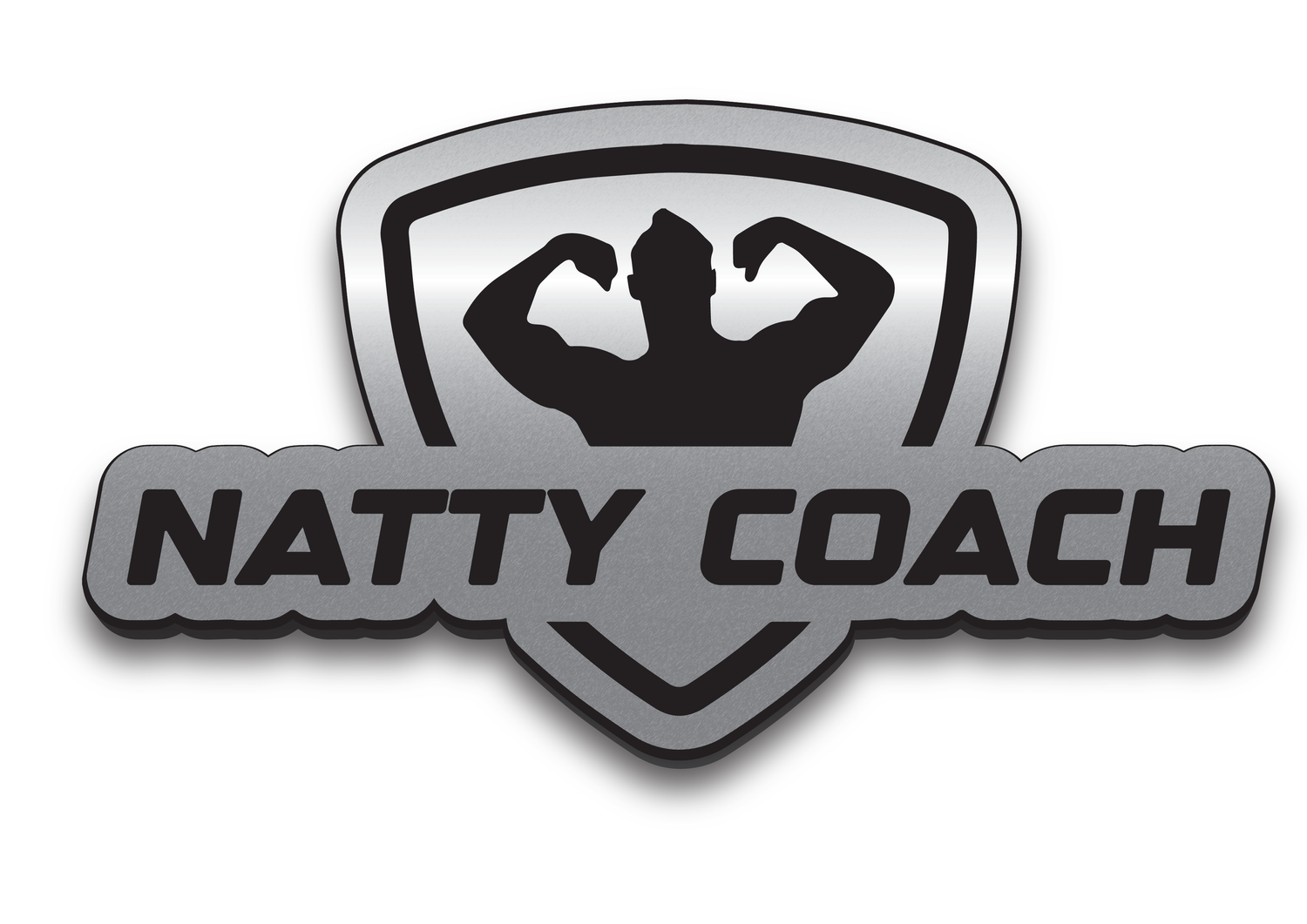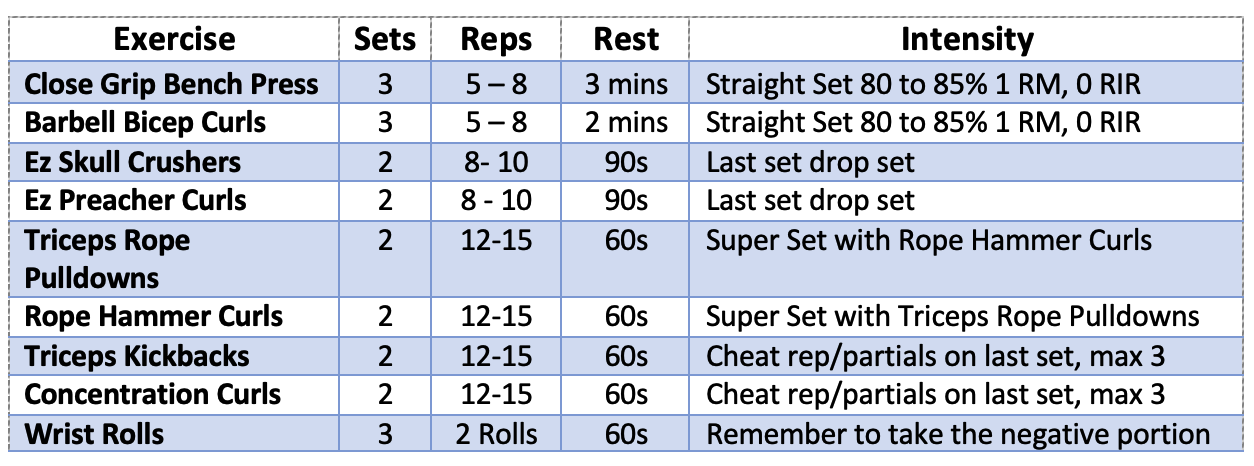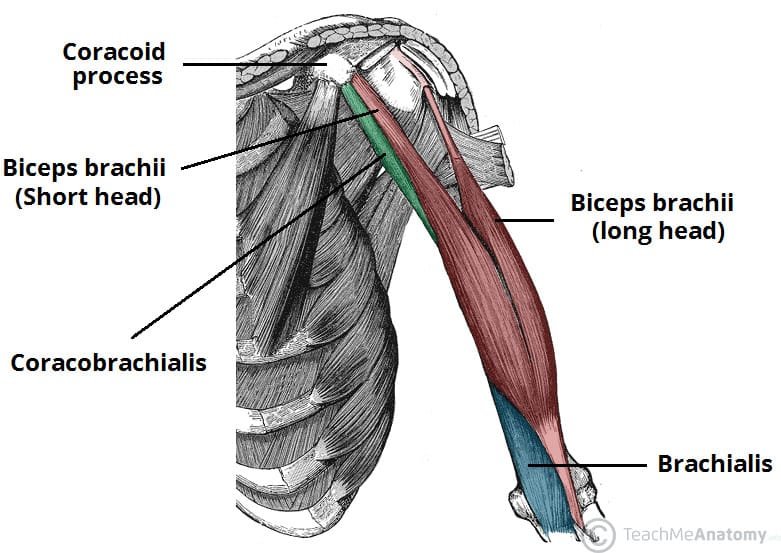Maximise Your Arm Development
Dr. Andrew Chappell
Here’s a favourite arm training routine of mine that I’ve incorporated into my training programs down the years. this plan assumes you’re training arms once per week as part of your training cycle.
Sample Arm Training Program, Once Per Week Microcycle
RM, Rep Max; RIR, Reps in Reserve
Introduction
Nothing says powerful like a set of big arms
I once read a somewhere that in bodybuilding “your arms can never be too big”. When I started training having e a well sculpted set of arms was the dream, all my action hero had great arms: Stallone, Van Dame, and of course the granddaddy of them all Mr Olympia Arnold Schwarzenegger. 15-year-old me didn’t know how to get them, but he sure as hell knew that he wanted them. That was over twenty years ago, and a lot has changed since then. Somethings never change though and thats the quest to get an even more impressive set of arms. So how do you go about doing this? Well there are a number of different approach you could take. Right out of the gates though, it’s worth pointing out that without the right dietary approach and recovery schedule you’ll struggle to develop a great arms. Moreover, without the correct technique, and a well-developed mind muscle connection you’ll also struggle to develop your arms. Finally genetics are important, the shape of your arms and your ability to build muscle here is somewhat predetermined and an approach that works for one person might not work for yourself. So with all that aside, let’s get into it.
Programming
When it comes to programming for bodybuilding, it’s important to implement progressive overload. This means that session after session, week on week, you as the trainer should always be looking to challenge yourself. You can progress in multiple ways, but usually it means: either lifting more weight on a single exercise, or as part of the whole session, performing more repetitions, doing more sets, reducing the rest between sets, or increasing the frequency you train that muscle group per week. We call this the FITT principle (frequency, intensity, time and type). The goal should always be progression; however, every program has a shelf life and this is the point at which you can no longer progress with the variables. On top of that, people get bored, so it’s important to change things up and keep them fresh if you want to stay motivated. Goals of a specific program or “mesocycle” vary, however you should be looking to change programs every 4 to 16 weeks as part of a larger “macrocycle”. In this respect programming should always fit into the wider context of the year-round goal. This context is important, as at times you may find yourself training arms, once, twice or three times per week through a variety of different rep ranges and alternating exercises. There is no perfect plan, only the one that makes the most sense for that phase of the macrocycle.
Programming for the arms specifically, its always worth considering the arms play an important role as accessory, or secondary muscles when it comes to pushing (triceps), or pulling (biceps & forearms) sessions. Moreover, even within the context of pushing or pulling movements, the arms stabilise as antagonist muscles. The biceps although not directly involved still play a role in stabilising the arm during pressing movements for example. What this means is that regardless of the split you do, be it push, pull, legs, bro split, full body, upper lower etc. your arms get a lot of indirect work. It also means that where you train the arms directly any fatigue can have direct consequence for the larger exercises involving the back, chest or shoulders. For example. sore triceps from the day? Don’t expect to perform as well on the bench press. With that in mind, experience has taught me that between 9 to 12 sets per week of direct work for the biceps and triceps is usually enough for most people, while around 6 sets seem to be enough for forearms. You could split this over the course of the week with a few exercises per session, or if you preferred, direct arm work. Where you have dedicated sessions to muscle groups, you’re likely to be more focused and be able to put more effort into training that muscle group. If you always train arms thrown in at the end of a session you might not progress at the rate needed to reach your goals. So how do you train your arms?
Training The Arms
The Biceps and Forearms
The biceps, located on the front of the upper arm, are responsible for flexing the elbow. To effectively target the biceps, it's important to understand the anatomy of the muscle. The biceps brachii, the muscle commonly referred to as the "biceps," has two heads: the short head and the long head. The short head is located on the inner portion of the arm, while the long head is located on the outer portion. Alongside the Bicep brachii, there is also the Brachialis and Brachioradialis which also play a role in flexing the elbow and supinating and pronating the forearm. There are of course more muscles of the forearm such as the Flexor Digitorum profundus and Felxor Palrmaris longus which play a role in flexing the fingers so are therefore important when it comes to grip. What this all means of course is that different exercises place a different emphasis on each muscle and for this article we will be primarily focused on the Biceps brachii, Brachiallis and Brachioradialis.
As with most muscle groups, compound exercises work well at providing an overall stimulus. Barbell curls are a an excellent compound which will target the whole arm, particularly the outter heads of the brachii and brachiallis, although the narrower grip you use the more you can shift the emphasis onto the inner head of the brachii, this is where an ez bar can also be particularly useful. Dumbbell curls on the other hand (no pun intended) which require the rotation (supination and subsequent pronation) of the wrist offers greater recruitment of the inner head of the brachii and the brachioradialis. Seated movements or movements which emphasis pronation (palms facing up) also place more emphasis on the inner brachii head. Exercises selection for an arm session should therefore always include some combination of barbells, dumbbells, cables or single arm movements. As well as barbell curls, personal favourites for me include barbell curls, preacher curls (with either an ez or straight bar), seated incline dumbbell curls, cable overhead curls and concentration curls. The program gaol will always determine the rep range selected but as a general rule I usually opt for lower rep (5 to 8) on the bigger movements, e.g. barbell curls, compared to higher reps (12 to 15) more isolation work like concentration curls.
Forearms is an area which is often overlooked by trainers and weak forearms stand out when it comes to classical posing such is their prominence in the old school shots. Forearms have never been an issue for me. I think this is because I always wanted good forearms and I’ve never struggled with grip. I did a lot of strongman training when I was younger, and I’ve never really used wrist supports. As a result, I’ve pulled a 180kg deadlift from the floor, using a double overhand grip, pulled over 240kg using mixed grip and managed a 20m farmers walk with over 130kg without dropping it. The moral of this story is you need to train the forearms if you want them, and don’t be overly reliant on your wrist wraps or straps. You should force yourself to do at least some of the work during your back sessions without them.
When it comes to training the forearms hammer curls can be effective as well as being a great timer saver. They can be incorporated into your bicep training sessions as the brachialis, brachioradialis and outer head of the brachii are all targeted. Hammer curls work well performed with dumbbells as well as with cables. To directly target the flexors of the forearm, exercises such as wrist curls and reverse wrist curls are effective. These exercises place the forearm in a position where the flexors are the primary muscle group being worked. My all-time favourite exercise for the forearms though is a wrist roller. Agony and burning doesn’t even begin to describe it. For those who have used one, you know what I mean. Some light weights placed on the end of a simple rope which you wheel against gravity is extremely effective. Three sets of these combined with some wrist curls and hammer curls can add some much-needed density to the forearm. For those doing more strength training-based work the farmers walk is also a personal favourite. Higher reps seem to be more productive for forearm training, probably owing to their size and make up of slower twitch muscle fibres, so aim for sets of between 15 to 25 reps.
Triceps
The Triceps brachii, located on the back of the upper arm, are responsible for extending the elbow. Commonly referred to as the "triceps," it has three heads: the lateral head, medial head, and long head. Shaped like an upside-down horseshoe the triceps are a much larger muscle group than the biceps, so maximising their development can really bring a whole new dimension to the arms. The triceps are also far stronger than the biceps and increasing your strength here can really make a difference to pressing movements like the bench press, or overhead press, so expect to be handling much more weight. Like the biceps different exercises will emphasise the different heads of the triceps. Straight out of the gates the biggest compound movement you can expect to do for triceps is the close grip bench press. Simply put, it’s a big movement where you can expect to use a lot of weight which targets both the long and the medial head of the triceps, although if truth be told it hits all three heads well. It’s a great movement that should be in every arm training plan. While on the topic of bench it’s also mentioning though if you do a powerlifting, it’s likely you’ll be getting a great triceps hit with the tucked elbow style of benching, compared to the more elbow flared style you typically see amongst bodybuilders.
Other great movements for the triceps include the French press or skull crushers. The name of this one seems to be used almost interchangeably, but I’m referring to the movement performed lying down on a bench with the arms extended followed by flexion at the elbow until the weight comes down to your forehead. Hence the name expression skull crushers. Not to be confused with a behind the neck triceps extension, another useful movement. Skull crushers fit into the compound movement category and unlike the close grip bench offer much more of a hit on the lateral head of the triceps while still producing a stimulus to the medial and long heads. The only problem with this one though is that some people do experience some elbow pain with this movement. Dips performed with an upright posture, along with diamond push ups can also be useful exercises where isolation exercises are preferred while the fact, they’re bodyweight movements can be use to add in as AMRAPs (As Many Reps As Possible) at the end of the session where you’re looking for a great triceps burns. For me though an often-overlooked triceps exercise is kickbacks. As a single arm movement, I don’t think there’s many better. Stabilising the shoulder is key for this movement to eliminate momentum, but when executed properly kickbacks effectively isolate the lateral head of the triceps. My own preference is to use a dumbbell for this one, but a cable also works well. Just like bicep training with compound lifts I always prefer to work with more weight and lower rep rangers by comparison to the isolation movements usually performed with cables or dumbbells. However don’t be afraid to train your triceps with a variety of rep ranges.
A great set of arms should look food from every angle
Final thoughts and considerations
Advanced training techniques such as super sets as agonist/agonist or agonist/antagonist muscle groups, tri sets, and giants can be awesome for getting a great pump and a massive time saver. So don’t be afraid to try setting up circuits. Equally partials or matrix sets where you do exercises like bicep curl 21’s can also be fun. Single arm movements can also be great for developing that mind muscle connection, but you should be mindful of doing these when training with a partner as they can take up a lot of time and disrupt a session. Drop sets are also a personal favourite can be a safer way to perform set extenders when compared to cheat reps. The key to arm training is of course form. I’m emphasising this for the second time, because it’s just that important. Particularly if you have weak arms. The trainer should always have in the back of their mind while performing the set the goal of the exercise. Swinging the weight or using momentum can take the tension off the muscle and reduce its effectiveness. There’s nothing wrong with the occasional cheat rep or advanced training technique, but it shouldn’t be your modus operandi.
If you want to train with me and you think I can help get you to your goals, then be sure to get in touch and hit that sign up button today (Click Here)








